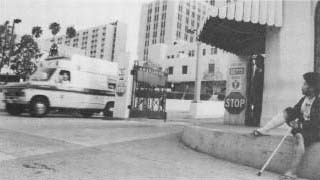Ambulance
The origin of the ambulance was tied to the needs of war. Battlefields were often miles from medical tents. An injured soldier could die on his to treatment if he had to be carried by men on foot. Although we may think of ambulances in terms of automobiles, earlier forms of ambulances were used as long ago as the middle ages, when men wounded in battle during the Crusades (a series of eight extended battles fought by European noblemen from 1095-1291 to protect the Christian Byzantine empire from Muslim Turks) were transported by horse-drawn wagons to centralized treatment centers.
Father of the Modern Ambulance
The modern ambulance—at least the horse-driven version—was cre-ated by Frenchman Dominique-Jean Larrey (1766-1842) in 1792. Larrey, Napoleon's private surgeon, wanted to improve battlefield treatment of wounded soldiers. He designed a horse-drawn "flying ambulance" to carry surgeons and medical supplies onto the field of battle during the Rhine campaign of 1792.
For the Italian campaign of 1794, Larrey used light ambulance carriages with stretchers to carry the wounded. In Egypt in 1799, local camels powered Larrey's ambulances. With fellow surgeon Pierre Percy (1754-1825), Larrey formed a battalion of ambulance soldiers, including stretcher bearers and surgeons. Larrey's ambulances and the swift medical attention they brought significantly boosted the morale of Napoleon's troops.
Ambulance service was expanded from the military to the civilian world in 1869 by Bellevue Hospital in New York City. The Larrey "flying ambulance" remained standard until the first motorized ambulances appeared around the turn of the century. These motorized vehicles were pioneered by the Panhard-Levassor partnership of France.

Air and Ground Ambulances
The first airborne ambulances were hot-air balloons used to evacuate wounded personnel from Paris during a Prussian siege in 1870. Heli-copters began to transport wounded soldiers during World War II (1939-1945) and became vital evacuation vehicles in the Korean (1950-1953) and Vietnam (1965-1973) wars. Today, air ambulances—both fixed-wing and helicopters—are increasingly used for quick transportation of patients, particularly in busy cities, but also in rural areas where medical care may be a great distance from the scene of an accident.
Until the mid-1960s, ambulances were mostly modified hearses, since these vehicles could transport patients in a supine (lying down on one's back) position. Since hearses were designed to carry corpses instead of living patients needing care, they had little room for supplies or attendants, let alone treatment en route to the hospital. A National Academy of Science/National Research Council report in 1966 focused attention on the need for both professional training of emergency medical technicians (EMTs) and improvements in ambulance design. This report resulted in today's modern van ambulance, with it's working space and sophisticated supplies and equipment. The van ambulance is operated by medical para-professionals, so that the ambulance is no longer simply a transportation vehicle—it is also a moving treatment center.
Comment about this article, ask questions, or add new information about this topic: